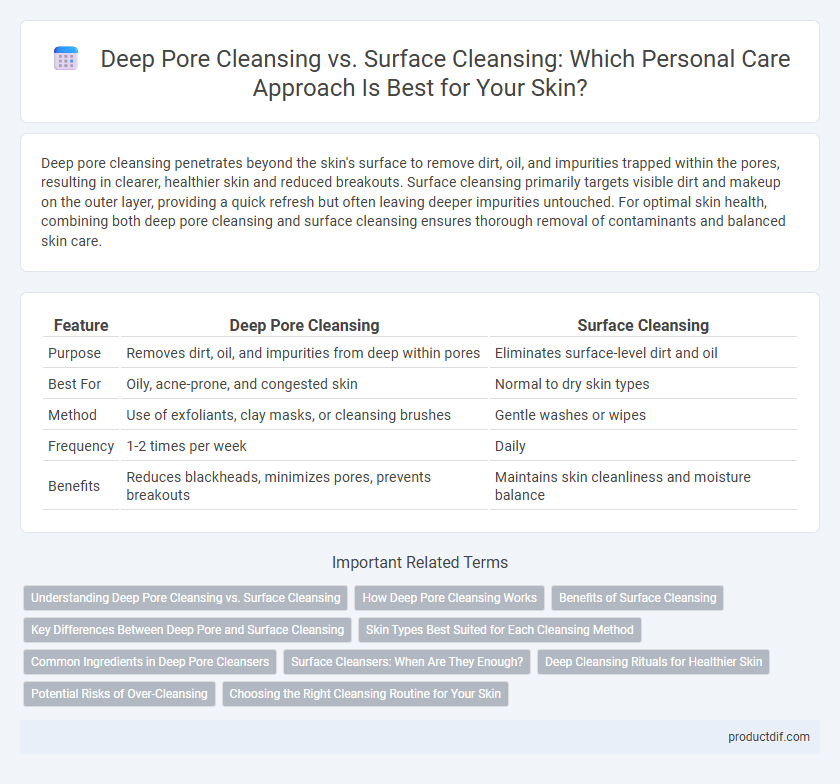Deep pore cleansing penetrates beyond the skin's surface to remove dirt, oil, and impurities trapped within the pores, resulting in clearer, healthier skin and reduced breakouts. Surface cleansing primarily targets visible dirt and makeup on the outer layer, providing a quick refresh but often leaving deeper impurities untouched. For optimal skin health, combining both deep pore cleansing and surface cleansing ensures thorough removal of contaminants and balanced skin care.
Table of Comparison
| Feature | Deep Pore Cleansing | Surface Cleansing |
|---|---|---|
| Purpose | Removes dirt, oil, and impurities from deep within pores | Eliminates surface-level dirt and oil |
| Best For | Oily, acne-prone, and congested skin | Normal to dry skin types |
| Method | Use of exfoliants, clay masks, or cleansing brushes | Gentle washes or wipes |
| Frequency | 1-2 times per week | Daily |
| Benefits | Reduces blackheads, minimizes pores, prevents breakouts | Maintains skin cleanliness and moisture balance |
Understanding Deep Pore Cleansing vs. Surface Cleansing
Deep pore cleansing targets the removal of impurities, excess oil, and dead skin cells trapped deep within the pores, promoting clearer skin and reducing acne breakouts. Surface cleansing primarily eliminates dirt, sweat, and makeup residue from the skin's outer layer, maintaining daily hygiene and preventing superficial buildup. Effective skincare routines integrate both methods to achieve optimal skin health by balancing deep pore detoxification with regular surface cleansing.
How Deep Pore Cleansing Works
Deep pore cleansing penetrates beneath the skin's surface to remove dirt, oil, and impurities trapped within pores, preventing acne and blackheads more effectively than surface cleansing. Specialized ingredients like salicylic acid or activated charcoal break down sebum and exfoliate dead skin cells deep inside pores, promoting clearer skin. This process enhances skin texture, reduces inflammation, and supports long-term skin health by targeting the root causes of clogged pores.
Benefits of Surface Cleansing
Surface cleansing effectively removes dirt, oil, and dead skin cells from the outermost layer, promoting a fresh and smooth complexion. It minimizes the risk of irritation and over-drying often caused by deep pore cleansing procedures. Regular surface cleansing enhances skin texture and supports a balanced moisture barrier for healthier-looking skin.
Key Differences Between Deep Pore and Surface Cleansing
Deep pore cleansing targets impurities trapped deep within pores, removing excess oil, dirt, and toxins to prevent acne and blackheads, while surface cleansing focuses on eliminating makeup, sweat, and surface-level dirt to maintain daily skin freshness. Deep pore cleansers often contain ingredients like salicylic acid or benzoyl peroxide to exfoliate dead skin cells and unclog pores, whereas surface cleansers typically use milder formulations such as micellar water or gentle foaming agents. Choosing between deep pore and surface cleansing depends on skin type and specific skin concerns, with deep cleansing beneficial for oily or acne-prone skin and surface cleansing suitable for sensitive or dry skin.
Skin Types Best Suited for Each Cleansing Method
Deep pore cleansing is ideal for oily and combination skin types prone to clogged pores and acne, as it removes excess oil and impurities from beneath the skin's surface. Surface cleansing suits dry and sensitive skin by gently eliminating dirt and makeup without stripping natural moisture. Choosing the appropriate cleansing method enhances skin health by addressing specific concerns related to sebum production and skin barrier sensitivity.
Common Ingredients in Deep Pore Cleansers
Deep pore cleansers commonly include ingredients such as salicylic acid, benzoyl peroxide, and charcoal, which penetrate deep into pores to remove dirt, oil, and impurities. Ingredients like clay (kaolin or bentonite) absorb excess oil and unclog pores, while tea tree oil offers antibacterial properties targeting acne-causing bacteria. These components work synergistically to provide a thorough cleanse beyond the skin surface compared to standard surface cleansers.
Surface Cleansers: When Are They Enough?
Surface cleansers are effective for removing dirt, oil, and makeup from the outer layer of the skin, making them sufficient for daily hygiene and maintenance in individuals with normal to oily skin types. They help maintain the skin's natural barrier without over-stripping essential moisture, which is crucial for preventing dryness and irritation. For those without severe acne or clogged pores, surface cleansing supports healthy skin and reduces the risk of over-exfoliation or damage associated with deep pore cleansing methods.
Deep Cleansing Rituals for Healthier Skin
Deep pore cleansing targets impurities and excess oils lodged deep within pores, preventing buildup that leads to acne and dullness. Incorporating deep cleansing rituals with ingredients like salicylic acid, clay masks, or charcoal helps detoxify skin, reduce inflammation, and improve overall texture. Consistent deep cleansing supports healthier skin by promoting clear pores, balanced oil production, and enhanced absorption of skincare products.
Potential Risks of Over-Cleansing
Deep pore cleansing targets impurities lodged deep within pores, often using exfoliating acids or physical scrubs, which can strip natural oils and disrupt the skin barrier if overused, leading to irritation and increased sensitivity. Surface cleansing removes dirt and makeup from the outer skin layer but excessive washing can still cause dryness, redness, and exacerbate conditions like eczema or rosacea. Maintaining balanced cleansing habits with gentle formulations minimizes potential risks and supports healthy skin function.
Choosing the Right Cleansing Routine for Your Skin
Deep pore cleansing targets impurities and excess oil trapped within the pores, reducing blackheads and preventing acne, while surface cleansing removes dirt, makeup, and environmental pollutants from the skin's outer layer. Selecting the right cleansing routine depends on your skin type, such as oily, dry, or sensitive, and concerns like acne or dullness to balance effective cleansing without irritation. Incorporate gentle deep-cleansing products for oily or acne-prone skin and milder surface cleansers for sensitive or dry skin to maintain optimal skin health and hydration.
Deep pore cleansing vs surface cleansing Infographic

 productdif.com
productdif.com